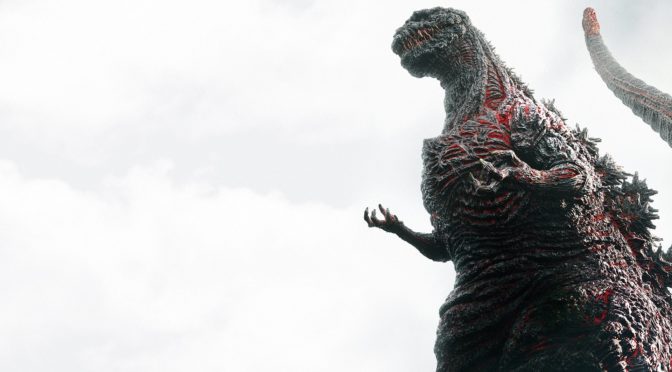There’s a reason why Godzilla is known as “The King of The Monsters” having been around now some 30 movies. He is so ingrained in Japanese culture and with so many films that there are eras of the beast, much in the same way there are with James Bond. With so many films it’s hard to guess where the monster goes next, I mean, when you have Godzilla fight and kill every monster alongside some superhumans in a single film, you’ve pretty much tapped that well dry. So it’s great to see that Shin Godzilla ditches all that history and start over again from the beginning.
This is a reboot to be sure, but it’s still nice knowing that Shin Godzilla takes many of its cues from the original Gojira film from the early 1950s. With a clean slate we get a far different film than any that have come before it in the mainline Toho universe. Gone are the silly monsters, the rubber suits, and the needless reliance of human superheros and space aliens. At it’s core Shin Godzilla is a story of how Japan, and the rest of the world would respond to a creature of this magnitude.
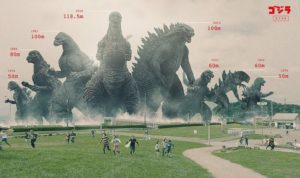
Because of this the human characters aren’t given much backstory or history. There are no forced love subplots to be found, no vast conspiracies to take power, and no robots or aliens anywhere. Instead we get a group of cabinet officials and scientific misfits working together to find a way to neutralize this Godzilla. This is important because they, and the audience, quickly come to learn that you can’t beat Godzilla. Watching these people work against overwhelming odds is a rewarding experience and something that is quite uncommon for a monster movie of this genre.
The film spends little time worrying about character development, instead keeping the audience on its toes as much as the characters about what the heck it going on. Much of the time when the film focuses on the characters it’s shot in a very gorilla style manner, with shaky cam and all. There are many point where the director seems to be going for a more documentary approach to the film which was an interesting direction to take. It never gets to Cloverfield levels, but you can tell that that film had some major influence.
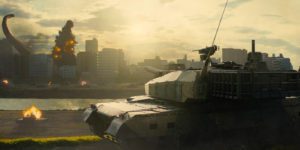
Where Shin Godzilla breaks from tradition is which the monster himself. The first half of the movie we see Godzilla rise from the ocean looking like a weird fish creature. He is done completely in CG, and while it’s not anywhere near Hollywood levels of quality, the design works in its favor. He is truly a grotesque beast that throws himself around in wild spurts, destroying anything and everything in his path. His early form is a truly disturbing sight.
As the movie goes on Godzilla begins to evolve in front of everyone until he takes on his final form that we all know and love. These stages of evolution are brutal, violent, and often times disturbing. All the while this is happening the teams in play continue to better understand the creature and how to deal with it. The Japanese PM is also being pressured by other world leaders to resolve this quickly before the UN is forced to intercede.
Shin Godzilla uses its characters and the downtime between Godzilla’s transformations to send a message to its audience, but you don’t have to be Japanese to understand it. There is talk about the US and how Japan is still beholden to them militarily in many ways, there is talk about the dangers of nuclear weapons and radiation (something that Fukishima brought to the forefront recently), and even talk of Japan’s place in the modern world. This is clearly more than simply a movie about a giant monster.
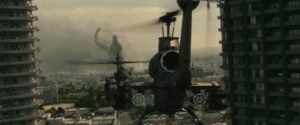
Godzilla is also more monster than ever before. All he knows is destruction and he comes well equipped to dish it out. There is no doubt that this interpretation of Godzilla is the most powerful Kaiju ever put to screen. As he evolves he gains more powers including his fire breath, but also these fusion powered lasers that can anticipate threats and more. Where in the past the humans could push the monster back from time to time, this isn’t the case here as all weapons used don’t even phase him. Godzilla truly is an unstoppable monster.
Where Shin Godzilla really stumbles is with its overall pacing. This makes a lot of sense as this film comes from the mind of the guy who is behind the narrative trainwreck that was Evangelion. While many of the pacing issues may not be as problematic for native Japanese audiences, everyone else is going to feel pretty lost and confused at times. It’s not uncommon to have five or six characters talking at the same time which is hard to follow, especially because the film does such a poor job of setting them up. You’ll often be left wondering who someone is and why they are important to the story. There is also a strange US sub-plot regarding the monster that simply fizzles out. Oh, and don’t get me started on the English actors they brought in for the few scenes they are in. It’s laughable how bad they are as well as the forced English by the Japanese actors.
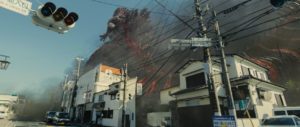
Still, the moments when Godzilla is rampaging through the various wards are fantastic and the music that accompanies him simply can’t be beat. And the last chunk of the film where Japan is faced with being nuked in order to stop Godzilla shows the very real struggle it’s people face being the only ones who truly understand what those weapons can do. Hollywood loves to threaten to launch nukes in action films like it’s just another Tuesday, but Shin Godzilla really gives us a look at just how intense and powerful a choice like that can be to the only people who have experienced it.
There is a lot left unanswered by Shin Godzilla after its 120 minute run, but that’s by design. Japan may have been able to stop the monster for the time being, but we all know that nothing can keep “The King of The Monsters ” down for very long.
“The King of the Monsters has truly returned in Shin Godzilla!”
3/5
“Good”

